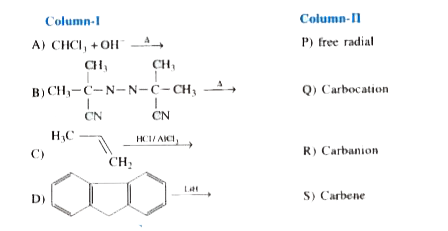Number of possible position isomers for dichlorobenzene isSolution in Telugu
2
3
4
5
The correct Answer is:B
Step by step video, text & image solution for Number of possible position isomers for dichlorobenzene is by Chemistry experts to help you in doubts & scoring excellent marks in Class 11 exams.
Topper's Solved these Questions
- BOOK - AAKASH SERIESCHAPTER - GENERAL ORGANIC CHEMISTRYEXERCISE - Objective Exercise -282videos
GENERAL ORGANIC CHEMISTRY
- BOOK - AAKASH SERIESCHAPTER - GENERAL ORGANIC CHEMISTRYEXERCISE - Practice Exercise80videos
GENERAL ORGANIC CHEMISTRY
- BOOK - AAKASH SERIESCHAPTER - GENERAL ORGANIC CHEMISTRYEXERCISE - Subjective Exercise -8120videos
GENERAL ORGANIC CHEMISTRY
- BOOK - AAKASH SERIESCHAPTER - ENVIRONMENTAL CHEMISTRYEXERCISE - EXERCISE ON PASSAGE (PASSAGE-III)5videos
ENVIRONMENTAL CHEMISTRY
- BOOK - AAKASH SERIESCHAPTER - HYDROCARBONSEXERCISE - ADDITIONAL PRACTICE SHEET ( LEVEL-II (PRACTICE SHEET (ADVANCED) (MATRIX MATCHING TYPE QUESTIONS)))5videos
HYDROCARBONS
Similar Questions
The compound containing sp sp2 and sp3 hybridised carbon atoms in 1:2:3 ratio is
02:22View SolutionThe compound CH3−CH∣CH3−CH∣CH3−CH3 contains
03:10View SolutionExplain the estimation of nitrogen of an organic compound by
(a) Dumas method and (b) Kjeldahl's method01:17View SolutionOzone layer acts as one of the most important life support system. The major cause of ozone layer destruction is believed to be the release of chlorofluorocarbon compounds. UV radiation causes the chlorofluouocarbons to dissociate : CF2Clhv−−→Cl⋅+CF2CI A highly reactive chlorine atomis responsible for the decomposition of ozone. Cl⋅+O3(g)→ClO⋅+O2(g)ClO⋅+O(g)→Cl⋅+O2(g) Free radicals of chlorine decompose ozone molecules in a chain reaction. The depletion of ozone layer leading to ozone hole has, however, been mainly observed in the stratosphere over Antarctica. Special type of cloud called polar stratospheric colouds are formed over Antarctica.These clouds (contain solid HNO3.3H2O) play an important role in ozone depletion.
ClO⋅+NO2→ClONO2
ClONO2+H2O→HOCl+HNO3
ClONO2+HCl→Cl2+HNO3
HOClhv−−→HO⋅+Cl⋅
The reactive chlorine atoms thus formed are rendered to deplete ozone layer.
The ozone layer is present in :View SolutionMatch the intermediates formed in the reaction.
 02:30View Solution
02:30View SolutionAssertion: p-Dichlorobenzene is less soluble in organic solvents than the corresponding o-isomer Reason o-Dichlorobenzene is polar while p-dichlorobenzene is non-polar .
03:16View SolutionThe number of possible dechloronitrobenzene isomers is
02:52View SolutionNumber of possible position isomers for Dichlorobenzene is
02:22View SolutionNumber of isomers possible for dichlorocyclohexane
View SolutionNumber of optical isomers possible for
 02:26View Solution
02:26View SolutionNumber of possible isomers of glucose is :
01:23View Solutionडाइक्लोरोबेन्जीन के सभी सम्भव समावयवियों की संरचना लिखिए।
01:23View SolutionAssertion: p-Dichlorobenzene is less soluble in organic solvents than the corresponding o-isomer
Reason o-Dichlorobenzene is polar while p-dichlorobenzene is non-polar .01:59View SolutionNumber of possible isomers of glucose is
03:08View SolutionNumber of possible isomers for C2H2Cl2
02:05View Solution

